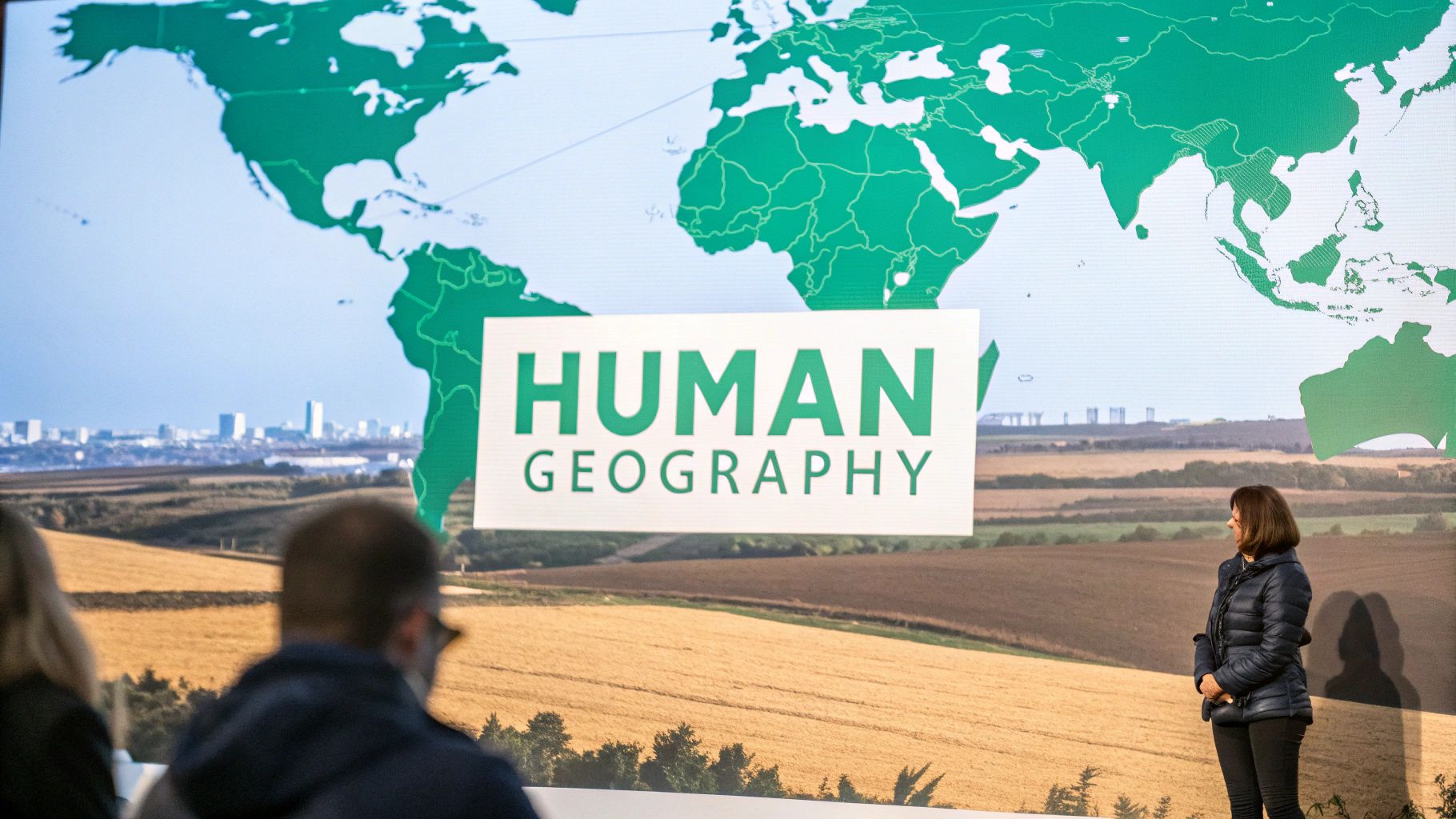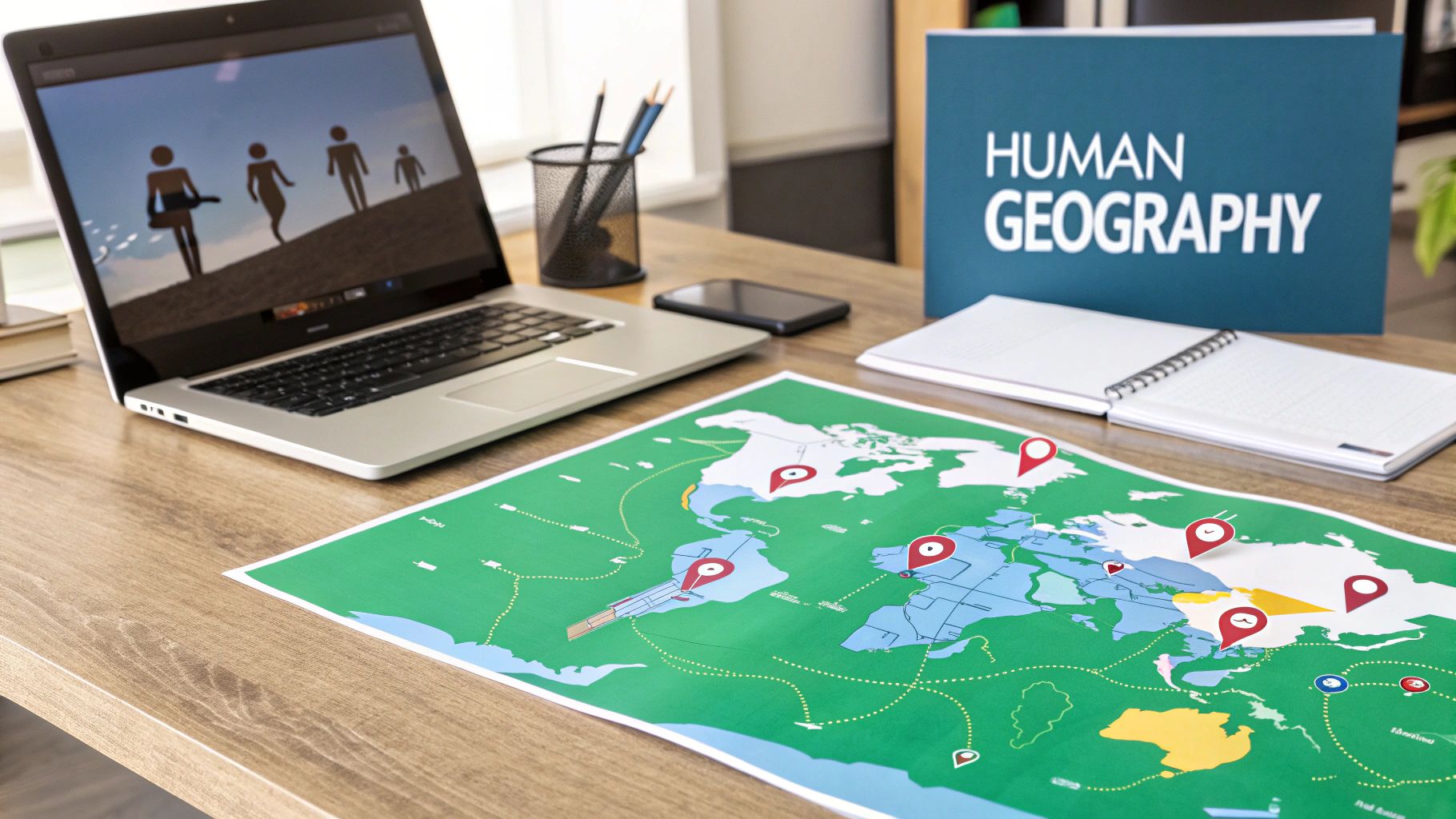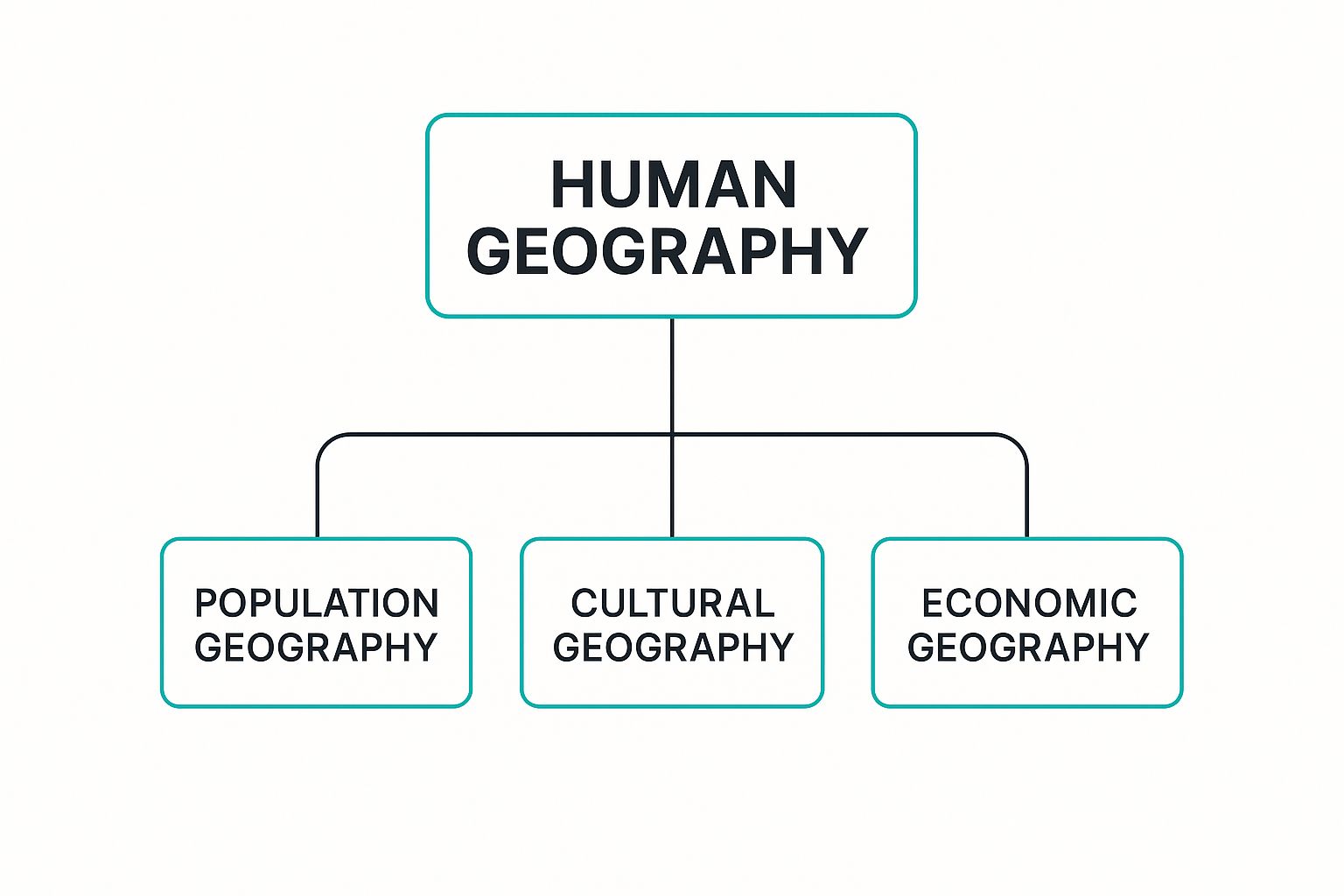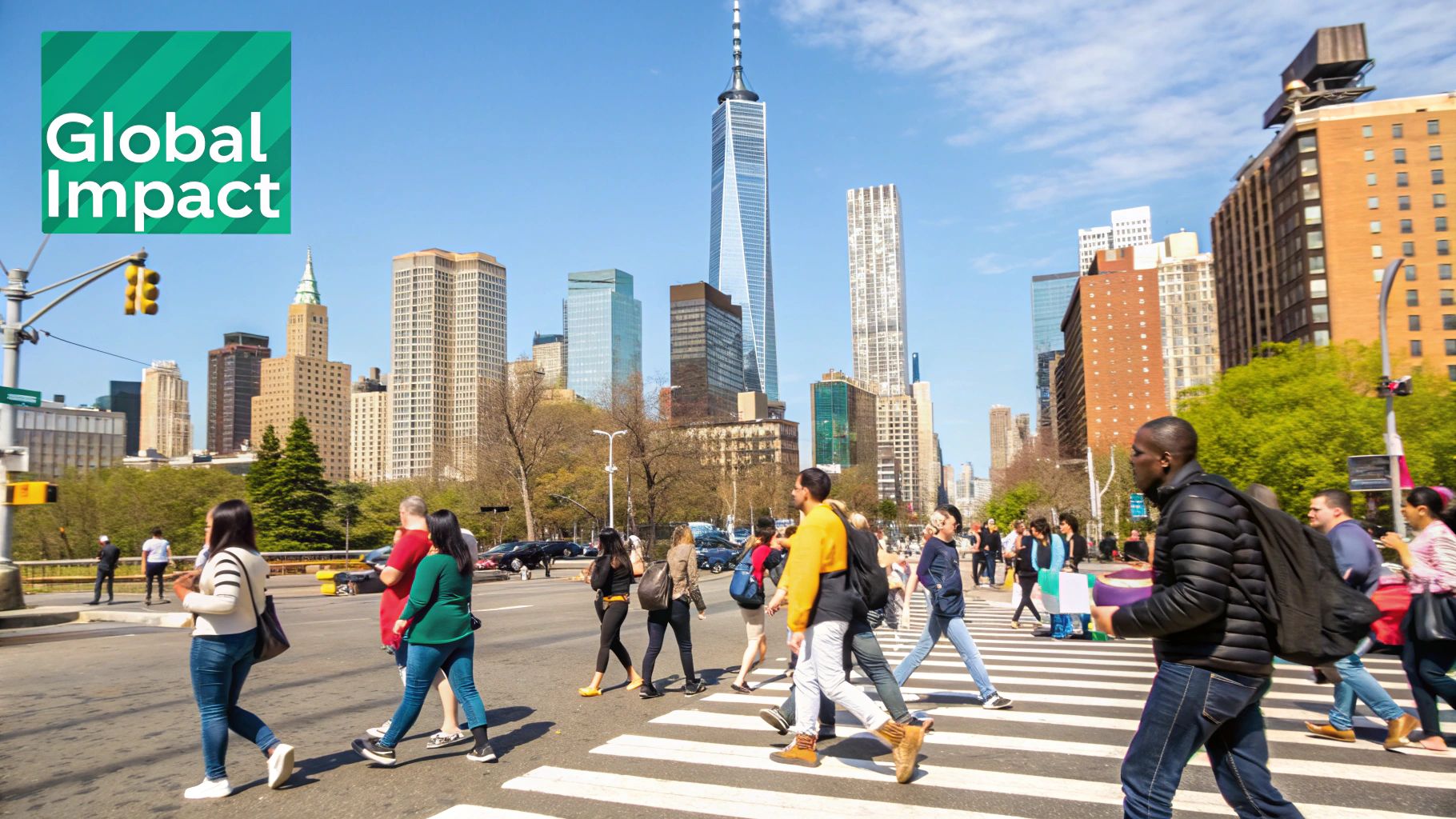What Is Human Geography Definition Explained Simply
A clear answer to 'what is human geography definition'. We explore its core themes, real-world examples, and why it's essential for understanding our world.

Let's be honest, "geography" often brings back memories of memorizing state capitals and coloring in maps. But what if I told you the real thing is a lot more interesting? Human geography is where the story of humanity crashes into the reality of our planet.
It's not just about knowing where things are. It’s about understanding the why behind the where. Why do cities spring up near rivers? How do mountain ranges shape cultural identities? How do we, in turn, leave our own mark on the world?
Defining Human Geography: Where People Meet Place

Think of our planet as a massive, ever-changing stage. Physical geography sets that stage—it’s the mountains, the oceans, the climate. But human geography is the drama that unfolds upon it. It’s the story of us.
This field digs into the dynamic, two-way relationship between people and the places they call home. A human geographer doesn’t just see a city on a coastline and move on. They start asking questions:
- How did being on the coast kickstart this city’s economy through shipping and trade?
- What unique traditions, foods, and dialects grew from a life tied to the sea?
- As the city grew, how did it change the coastline and the local ecosystem?
The Core Idea: People and Environment
At its heart, human geography is the study of how we organize ourselves across the Earth. It’s about the constant push and pull between our cultures, economies, and social structures and the physical world they exist in.
It shows us that the world isn’t just a random assortment of borders and towns. It’s a complex tapestry woven from billions of human decisions, cultural expressions, and environmental interactions. Every road, every farm, every city skyline tells a story.
Human geography is fundamentally about spatial relationships. It’s the art and science of understanding how human society is organized in space and how this organization affects our lives, our cultures, and our future.
This goes way beyond a simple dictionary-style answer for what is human geography definition. It gives us a powerful lens for making sense of everything from global supply chains to the layout of your own neighborhood. By spotting these patterns, we start to see the bigger picture behind some of the most critical issues we face today.
Tracing the Roots of Human Geography

To really get what human geography is, you have to look at where it came from. The field didn't just pop into existence. It grew out of our oldest questions about the world and our place in it. For thousands of years, people have been sketching out maps of their surroundings and telling stories about the profound link between people and place.
This fundamental curiosity was the bedrock. Early civilizations—whether in Greece, China, Rome, or the Islamic world—produced incredibly detailed maps and writings. They documented the lands and people they came across, driven by the practical needs of trade, military campaigns, and running an empire. These early works were the first seeds of geographic thought.
From Description to Deeper Meaning
For a long, long time, geography was mostly about description. It was about documenting 'what is where'—the curve of a coastline, the height of a mountain, the layout of a city. But the Age of Exploration, kicking off in the late 1400s, changed everything.
European voyages brought back a flood of new information about totally different peoples and environments. This explosion of knowledge forced thinkers to go beyond just describing what they saw. They started asking tougher questions. Why did this society develop farming while that one stayed nomadic? How did climate shape a culture’s religion or government? For more on this evolution, check out this deep dive into the history of human geography.
This was the pivot point. Geography went from simple map-making to meaning-making. It started to become a way to analyze the invisible forces that shape how we live, move, and build communities.
This new analytical approach really took hold in the 19th century when geography became a formal academic subject in European universities. Pioneers like Carl Ritter and Alexander von Humboldt pushed the idea that the Earth and its people were one big, interconnected system.
How a Classic Discipline Went Digital
The 20th century saw human geography evolve even further. The field started blending ideas from sociology, economics, and political science, giving it a much richer, more critical lens to view the world.
But the biggest shake-up was technology. The arrival of Geographic Information Systems (GIS) in the second half of the century was a total game-changer. Suddenly, geographers could layer massive amounts of data onto digital maps, revealing complex patterns that were once impossible to see.
For instance, with GIS, you could visually connect the dots between:
- Income levels and the location of grocery stores in a city.
- Pollution hot spots and public health issues in a region.
- Voting patterns and demographic data across an entire country.
This technological leap cemented human geography's place as a powerful, data-driven science. From the hand-drawn charts of ancient explorers to the complex digital models of today, its story is one of a relentless quest to better understand humanity’s intricate dance with the planet.
Exploring the Core Branches of Human Geography
Human geography isn't one single, giant subject. It’s more like a collection of specialized lenses, each designed to give us a sharper focus on a different part of the human experience on Earth.
By breaking the field down into its core branches, we can build a much richer map of how geographers investigate our world. Each subfield asks its own unique questions, but they all share the same fundamental goal: to understand the "why" behind the "where."
These different branches allow for a deep-dive, specialized view that still connects back to the bigger picture of human patterns.

This graphic gives you a quick snapshot of how foundational areas like population, culture, and economics act as pillars for deeper geographic questions.
To get a clearer sense of what each branch actually does, let's break them down. The table below outlines the core question each sub-discipline tries to answer and offers a simple, real-world example to bring it to life.
Key Branches of Human Geography Explained
| Branch | Core Question | Real-World Example |
|---|---|---|
| Cultural Geography | How do beliefs, traditions, and identity shape—and get shaped by—physical space? | The distinct architectural styles found in New Orleans' French Quarter, reflecting its historical European influences. |
| Economic Geography | Why are economic activities located where they are? | The clustering of tech companies in Silicon Valley, driven by a specialized labor pool and venture capital access. |
| Political Geography | How do power, politics, and governance create and influence territories and borders? | The gerrymandering of voting districts in the U.S. to influence election outcomes. |
| Urban Geography | How are cities structured, and what are the challenges and opportunities of urban life? | Analyzing how a new subway line impacts property values and neighborhood development along its route. |
| Population Geography | Where do people live, why do they live there, and how do populations change over time? | Studying Japan's aging population and its effect on the country's workforce and social services. |
Each of these branches offers a unique key to unlocking a part of the human puzzle, showing how interconnected our world truly is. Let's dig a little deeper into a few of them.
Cultural Geography
This branch gets to the very heart of human identity and its connection to place. Cultural geography investigates how our beliefs, languages, religions, and traditions carve their signatures onto the landscape—and, just as importantly, how the landscape shapes those cultures in return.
It's all about the visible and invisible imprints we leave on the world.
A fantastic example is the linguistic map of Switzerland. The country has four national languages (German, French, Italian, and Romansh), but the lines between them aren't random. They're the product of centuries of history, migration patterns, and the very real influence of physical barriers like the Alps. If you want to dive deeper, check out our guide on what is cultural geography.
Economic Geography
Ever wonder why tech startups flock to Silicon Valley? Or why so many call centers are based in India and the Philippines? Economic geography tackles exactly these kinds of questions by examining how economic activities are spread across space.
This field analyzes everything from massive global supply chains down to the logic behind where your local coffee shop decided to set up.
Think about the journey your smartphone took to get to you. Its parts were probably sourced from a dozen countries, put together in another, and then shipped to markets all over the planet. An economic geographer studies this mind-boggling network to understand the forces—labor costs, resource access, and logistics—that make it all possible.
Economic geography peels back the curtain on the global economy, revealing that where something is made is just as critical as what is made.
Political and Urban Geography
Two other crucial branches bring even more of the world into focus. Political geography zeroes in on how political power creates and shapes territories. It studies everything from how international borders are drawn and why conflicts arise to the way voting districts are carved out—a process that can define election results for years to come.
A classic example is the division of Berlin during the Cold War. It created a stark physical and ideological scar on the city, and you can still see its effects on the urban landscape today.
Finally, there's urban geography, which is all about the life and structure of cities. With over 55% of the world's population now living in urban areas, this field has never been more relevant.
Urban geographers explore the internal layout of cities, patterns of suburban growth, and tough challenges like housing shortages and traffic jams. They might analyze how a new bus route changes property values or how the location of parks can boost a community's health, helping us design cities that are better for everyone.
The Modern Geographer's Toolkit
Embedded content
So, how do human geographers actually uncover the stories hidden within our landscapes? It's not just about intuition. They use a powerful and diverse set of tools to transform raw data into profound insights, blending old-school, human-centric investigation with high-tech analysis.
On one side, you have qualitative methods, which are all about understanding the human experience. These tools capture the nuances of culture, belief, and personal perspective that raw numbers could never convey.
Think of it like being a detective of human stories. A geographer might conduct in-depth interviews with residents of a neighborhood undergoing gentrification, or even live within a community to observe its daily rhythms through ethnographic fieldwork. This approach delivers a rich, textured understanding of a place.
Powering Up with Quantitative Tools
On the other side of the toolkit are quantitative methods. These are all about finding large-scale patterns and relationships using numerical data and statistical crunching. This is where geographers zoom out to see the bigger picture that individual stories might miss.
For instance, a researcher might use spatial statistics to comb through census data across an entire country, looking for links between income levels and access to fresh food. This method is absolutely essential for identifying broad trends and making evidence-based policy recommendations.
The real magic of modern human geography happens when these two approaches are combined. By pairing the deep human understanding from qualitative work with the broad patterns revealed by quantitative data, geographers create a truly holistic and compelling picture of our world.
This synthesis is what turns the discipline into a hands-on, tech-savvy field capable of tackling incredibly complex problems.
The Game-Changer: Geographic Information Systems
Perhaps the single most important tool in the modern geographer's arsenal is Geographic Information Systems (GIS). Imagine being able to stack multiple transparent maps on top of each other, where each map shows a different type of information for the exact same area. That's the basic idea behind GIS.
This technology allows researchers to layer different datasets onto a single map, making connections visible that would otherwise be completely hidden. A geographer could layer maps showing:
- Layer 1: Locations of industrial factories releasing pollutants.
- Layer 2: Dominant wind patterns and airflow in the region.
- Layer 3: Neighborhoods with the highest rates of childhood asthma.
Suddenly, a clear, undeniable, and actionable link between pollution sources and public health emerges from the data. This is the power of GIS—it makes complex spatial relationships instantly understandable. It’s a foundational technology that has transformed how we approach everything from urban planning to disaster response.
To see just how impactful this tool is, you can learn more about what Geographic Information Systems are and how they are used across countless fields.
Human Geography in the Real World

The real test of any academic field is whether it can solve actual problems. This is where human geography truly comes alive, leaping from theory and data into tangible solutions that shape our everyday lives.
These principles aren't just for textbooks; they're actively used to build better communities and tackle global challenges.
When you see a city adding bike lanes or a company rerouting its shipping to avoid port congestion, you're seeing human geography in action. It gives us a framework for understanding complex systems and making smarter, spatially-aware decisions. The insights gained help address some of the most pressing issues we face today.
Designing Smarter and Fairer Cities
One of the most visible applications of human geography is in urban planning. Geographers don't just see streets and buildings; they see a dynamic system of movement, access, and opportunity.
By analyzing data on foot traffic, public transit use, and the location of essential services, they can help design more livable cities.
For example, an urban geographer might map out grocery store locations and identify "food deserts"—entire neighborhoods where residents can't easily access fresh, healthy food. This kind of spatial analysis can directly spark policy changes, like offering incentives for new markets or creating better bus routes to connect people to what they need.
It’s about creating healthier, more equitable communities for everyone.
Similarly, geographers might analyze commuter patterns to recommend new subway lines that could slash traffic congestion and carbon emissions. These interventions come from a deep understanding of how people actually move through and live in their city.
Strengthening Global Systems and Environments
Beyond the city limits, human geography gives us critical tools for managing global networks and resources. Economic geographers, for instance, map out the intricate webs of global supply chains.
When a hurricane or political conflict disrupts trade in one part of the world, their analysis helps businesses anticipate shortages and find alternate routes. It makes our entire economy more resilient.
Human geography is about more than just observing the world; it’s about actively participating in its improvement. It connects the dots between location, human behavior, and well-being, providing a roadmap for positive change.
This perspective is also essential for sustainability. By understanding how human activities affect different landscapes, we can manage our natural resources more effectively and protect fragile ecosystems. This work often overlaps with other disciplines, which you can explore further in our guide to what is environmental geography.
From public health officials tracking disease outbreaks spatially to agricultural planners working to ensure food security, the applications are nearly endless. Human geography equips us not just to understand our world, but to actively build a better one.
Why Human Geography Matters More Than Ever
In a world that feels more connected—and more complicated—by the day, learning to think like a geographer has become a critical life skill. At its heart, human geography is all about understanding the deep-rooted relationship between people and the places they inhabit. It's the key to unlocking today’s biggest global challenges.
Think about it. From climate change and refugee crises to economic inequality and urban sprawl, the toughest problems we face are geographic problems. They're tangled up in how we use the planet's resources, how we build our cities, and how we interact across borders. Without a geographic lens, you're only seeing half the picture.
A Framework for Better Decisions
A solid grasp of human geography gives you the context to make smarter decisions—as a consumer, a voter, and a citizen of the world. It equips you to ask the right questions.
- How does the stuff I buy online impact workers on the other side of the planet?
- Why are some neighborhoods hit so much harder by natural disasters?
- How do invisible political lines on a map determine who gets access to life-saving healthcare?
The real power of human geography is that it provides a framework for understanding—and hopefully improving—the world we all share. It takes us beyond just knowing facts and helps us see the complex, interconnected systems that shape our lives.
Common Questions About Human Geography
As you dive into the world of human geography, a few questions always seem to come up. Let’s tackle some of the most common ones to give you a clearer picture of this fascinating field.
What’s the Main Difference Between Human and Physical Geography?
Think of it this way: Physical geography is the study of the Earth’s stage—the mountains, rivers, climates, and natural processes that form the backdrop of our world. It's the "what" and "where" of the planet's physical systems.
Human geography, on the other hand, is about the actors on that stage. It’s the story of humanity: how we build cities, create cultures, establish economies, and interact with the environment. It focuses on the human drama unfolding across the globe.
In short, one studies the planet, and the other studies the people on the planet. They are two sides of the same coin, and you can’t fully understand one without the other.
Is Human Geography Considered a Social Science?
Absolutely. While it has deep roots in the Earth sciences, modern human geography lives squarely in the world of the social sciences. It pulls in ideas and methods from sociology, economics, anthropology, and political science to make sense of human patterns.
What makes it unique is its relentless focus on space and place. A sociologist might study why a community faces economic hardship, but a human geographer will ask where that hardship is concentrated and why it’s happening in that specific location, linking social issues directly to their geographic context.
What Kind of Careers Can You Pursue with a Background in Human Geography?
A degree in human geography doesn't just lead to one specific job—it opens up a surprisingly diverse range of career paths. The core skill you learn is how to think spatially and see the connections between people, places, and systems. That's a powerful tool in almost any industry.
Here are just a few of the paths people take:
- Urban and Regional Planner: You could be shaping the future of cities, designing more sustainable, equitable, and livable communities.
- GIS Analyst: Using Geographic Information Systems, you'd map and analyze data for everyone from environmental agencies to tech companies.
- Market Research Analyst: Big companies need to know where to build their next store. You'd be the one analyzing demographics and consumer behavior to tell them.
- Transportation Manager: Your job would be to plan more efficient and accessible bus routes, subways, and transport networks.
- International Development Worker: You could work with non-profits and NGOs to tackle global challenges like food security or public health in specific regions.
Ready to explore the world in a whole new way? With EarthChasers, you can turn geographic knowledge into an exciting adventure. Our 3D game makes learning about diverse landscapes and cultures an interactive quest. Discover new wonders and test your skills on EarthChasers today!
